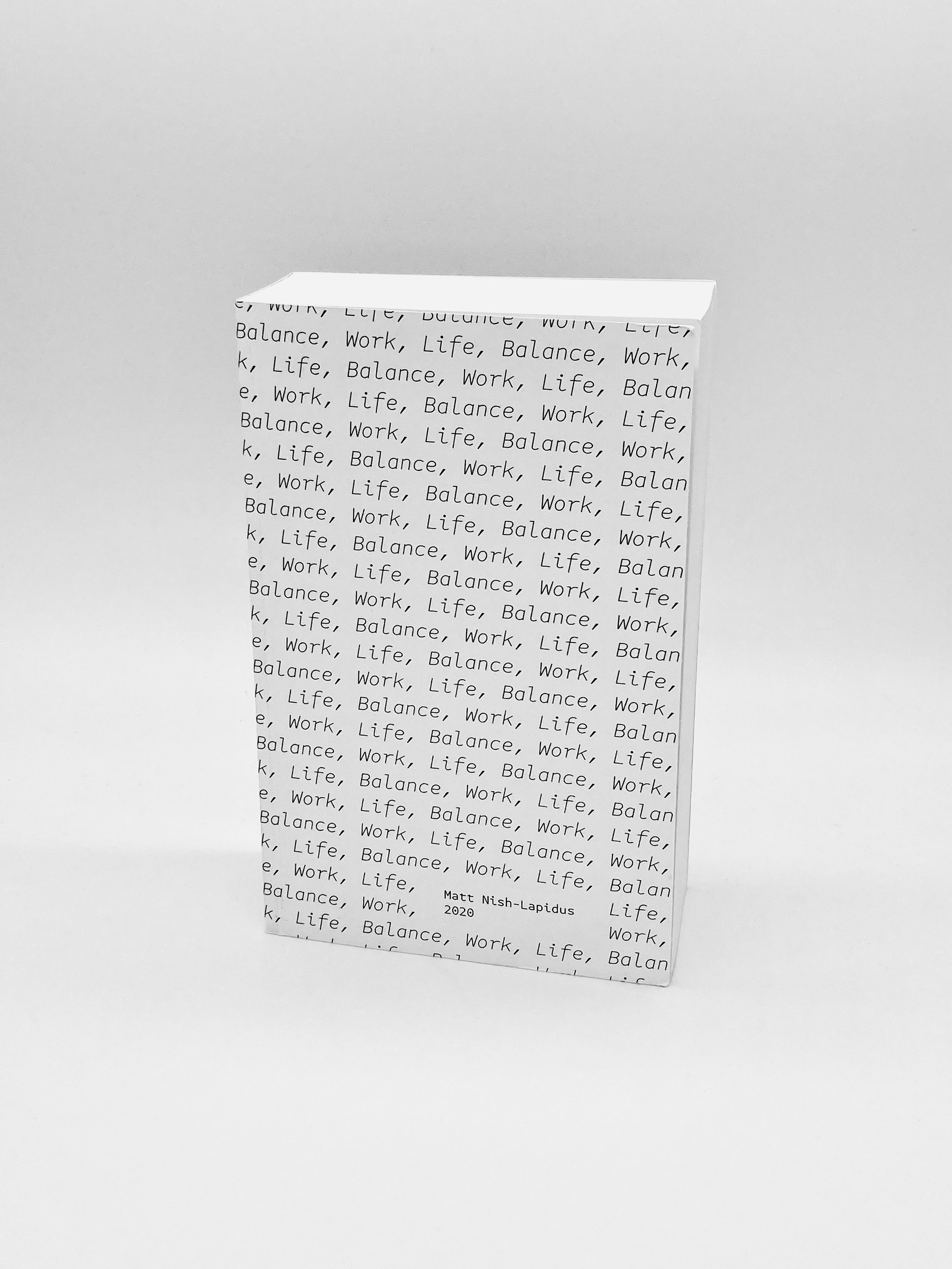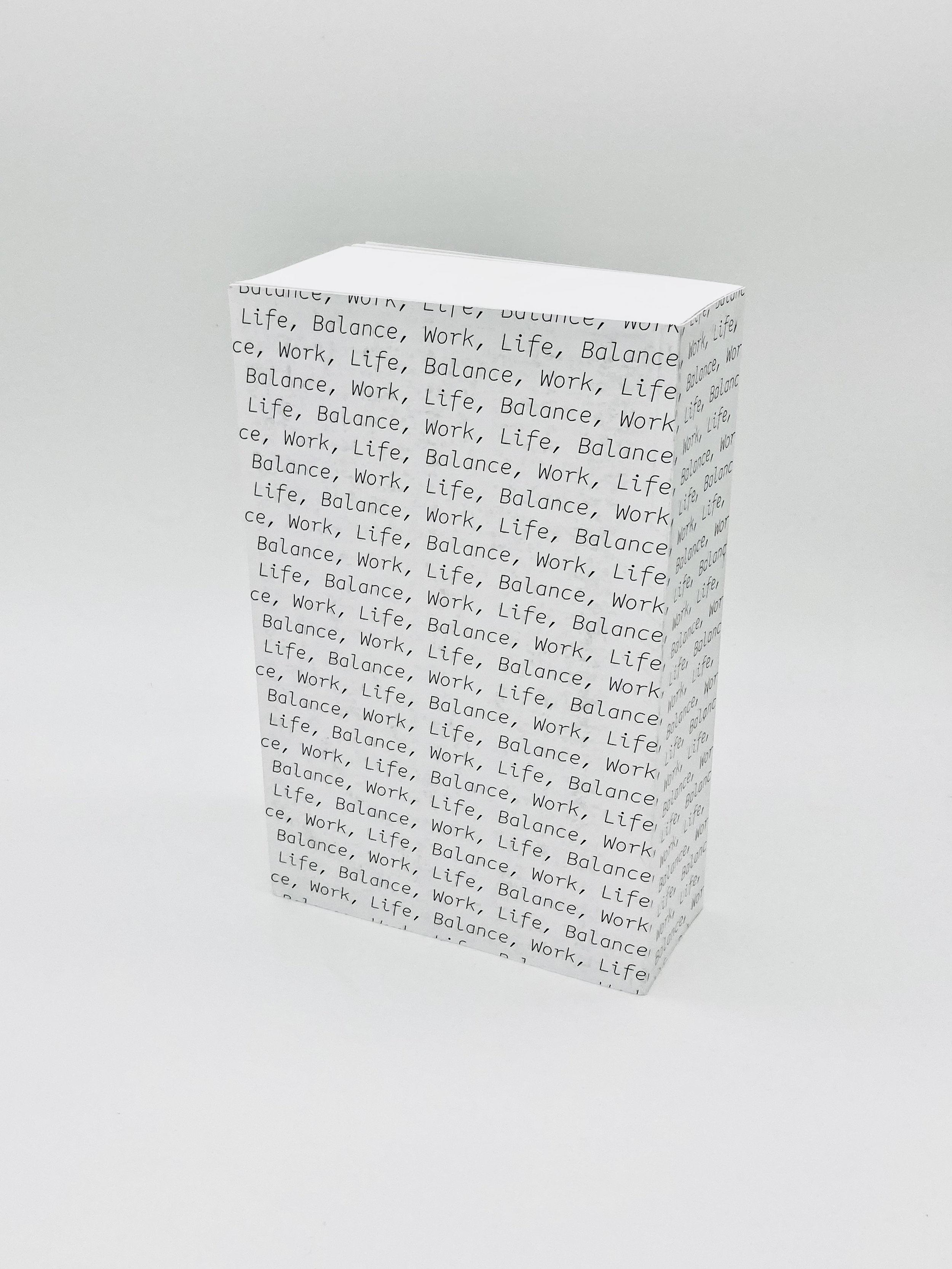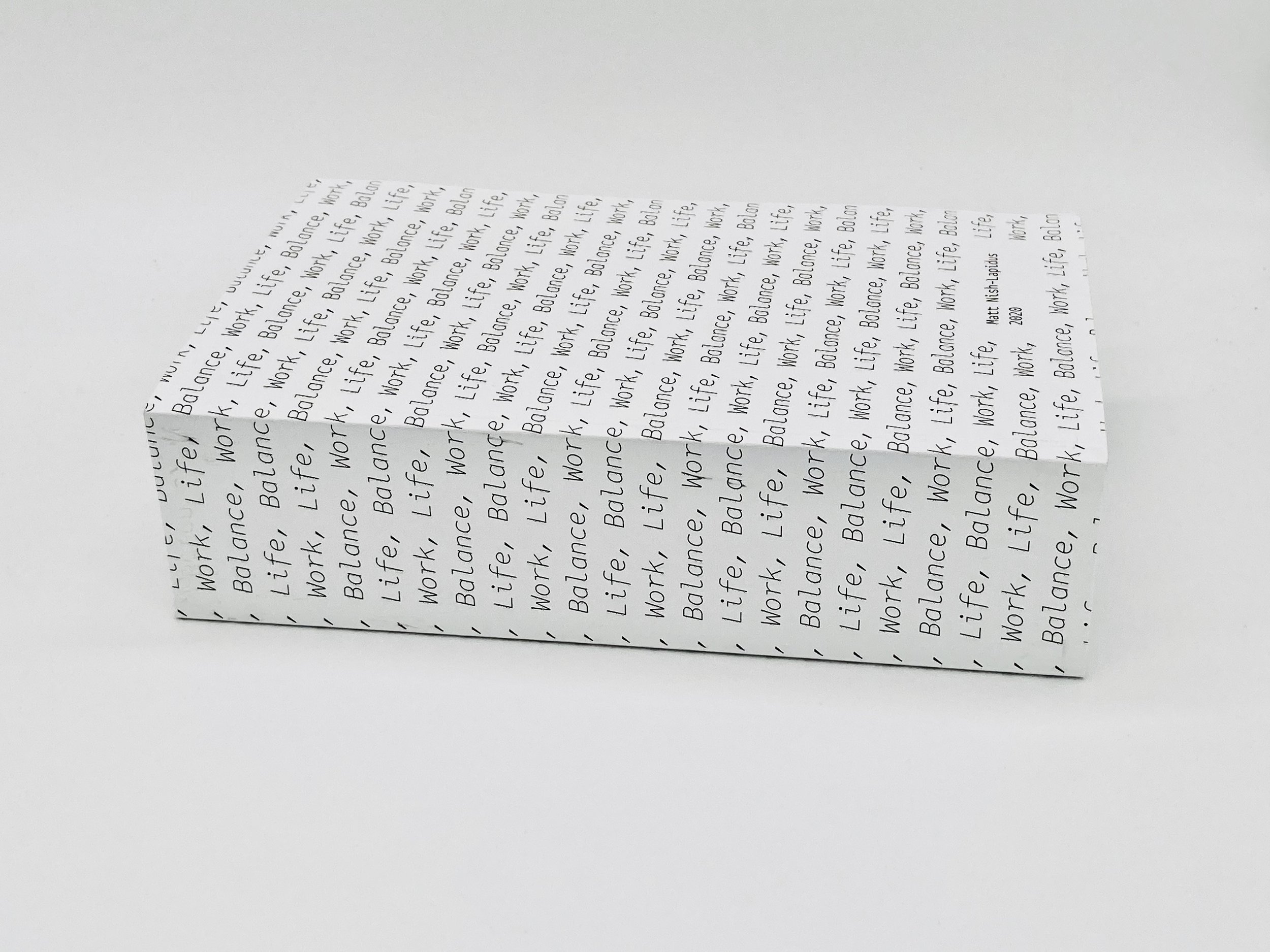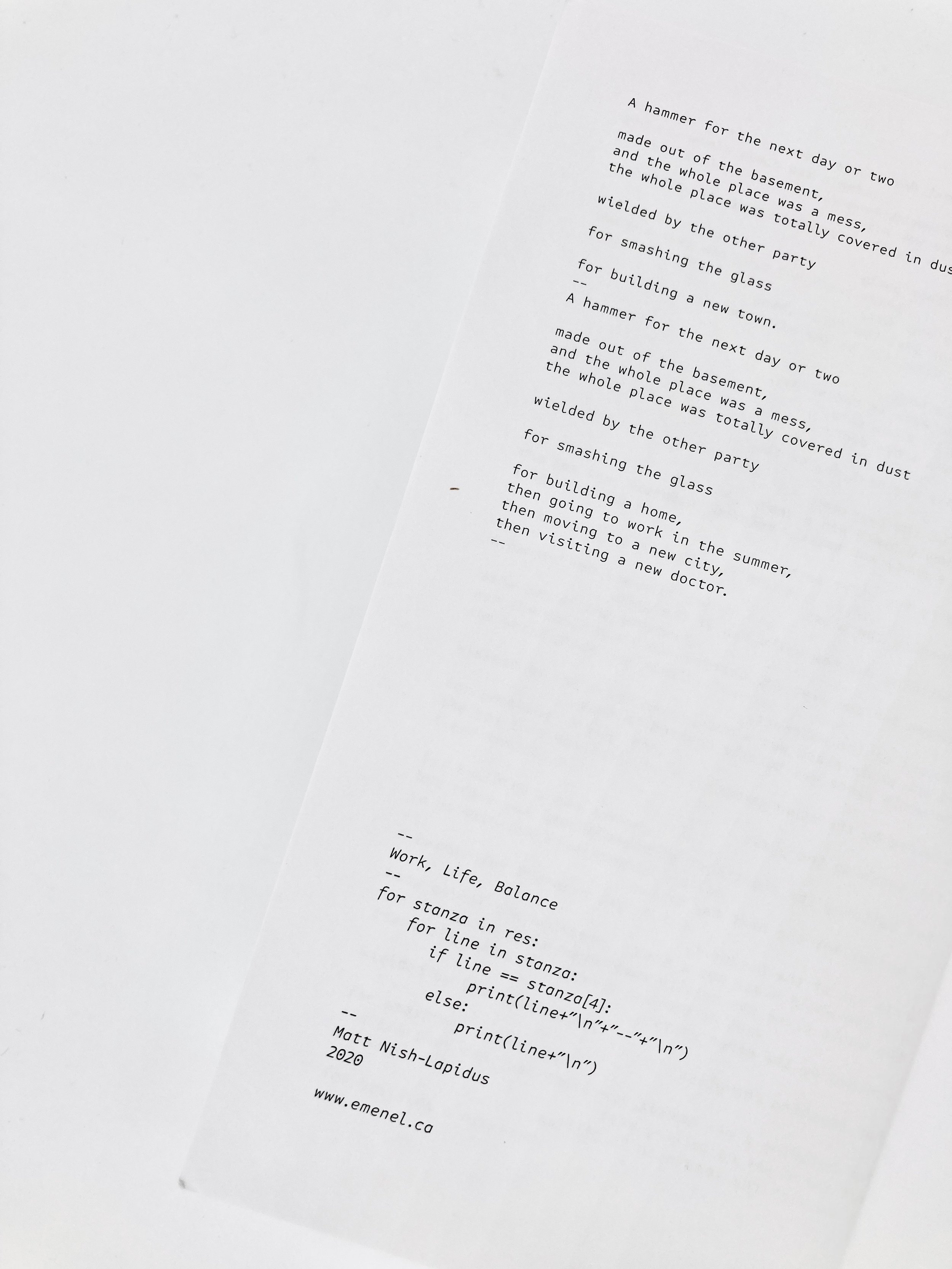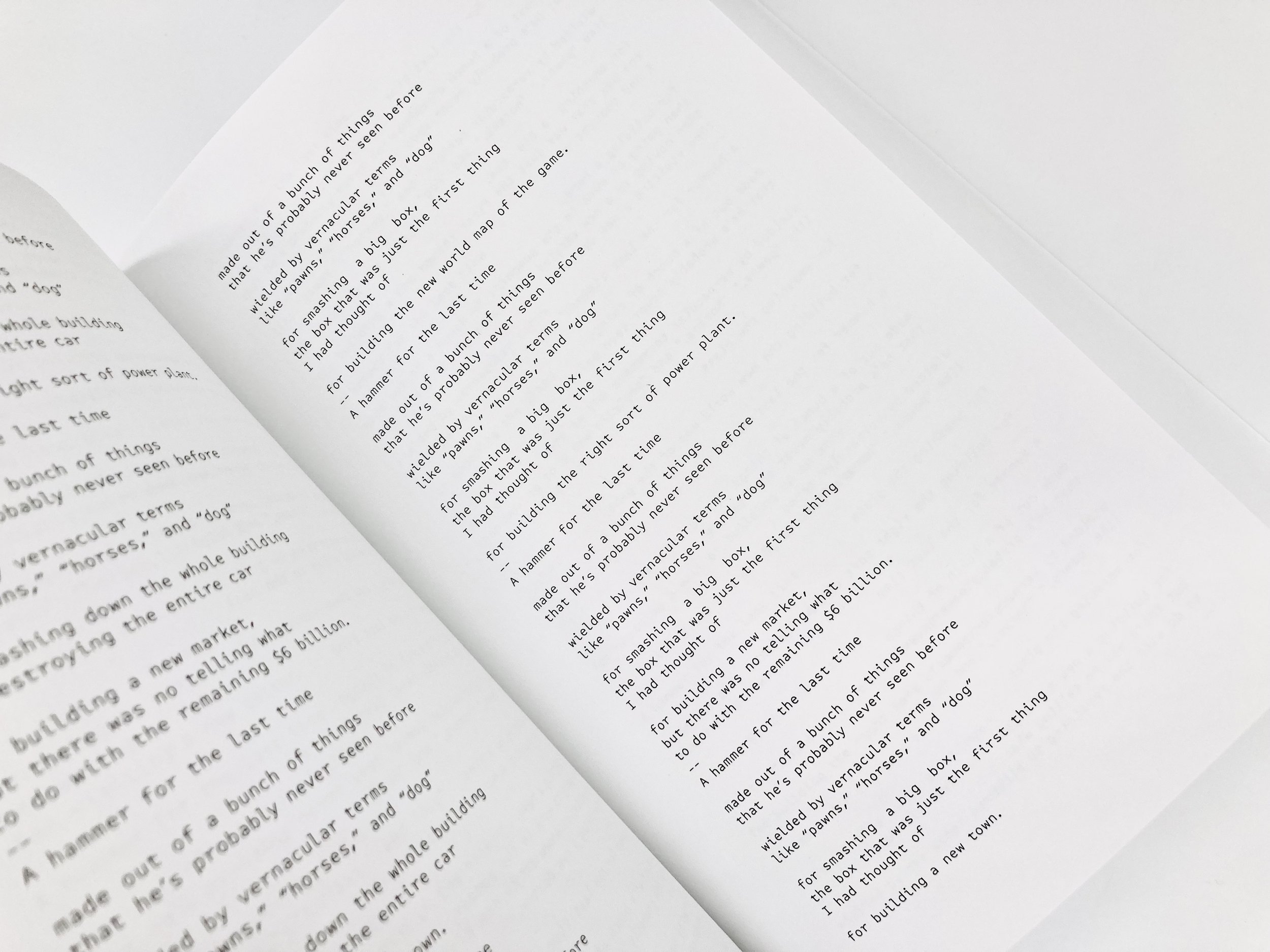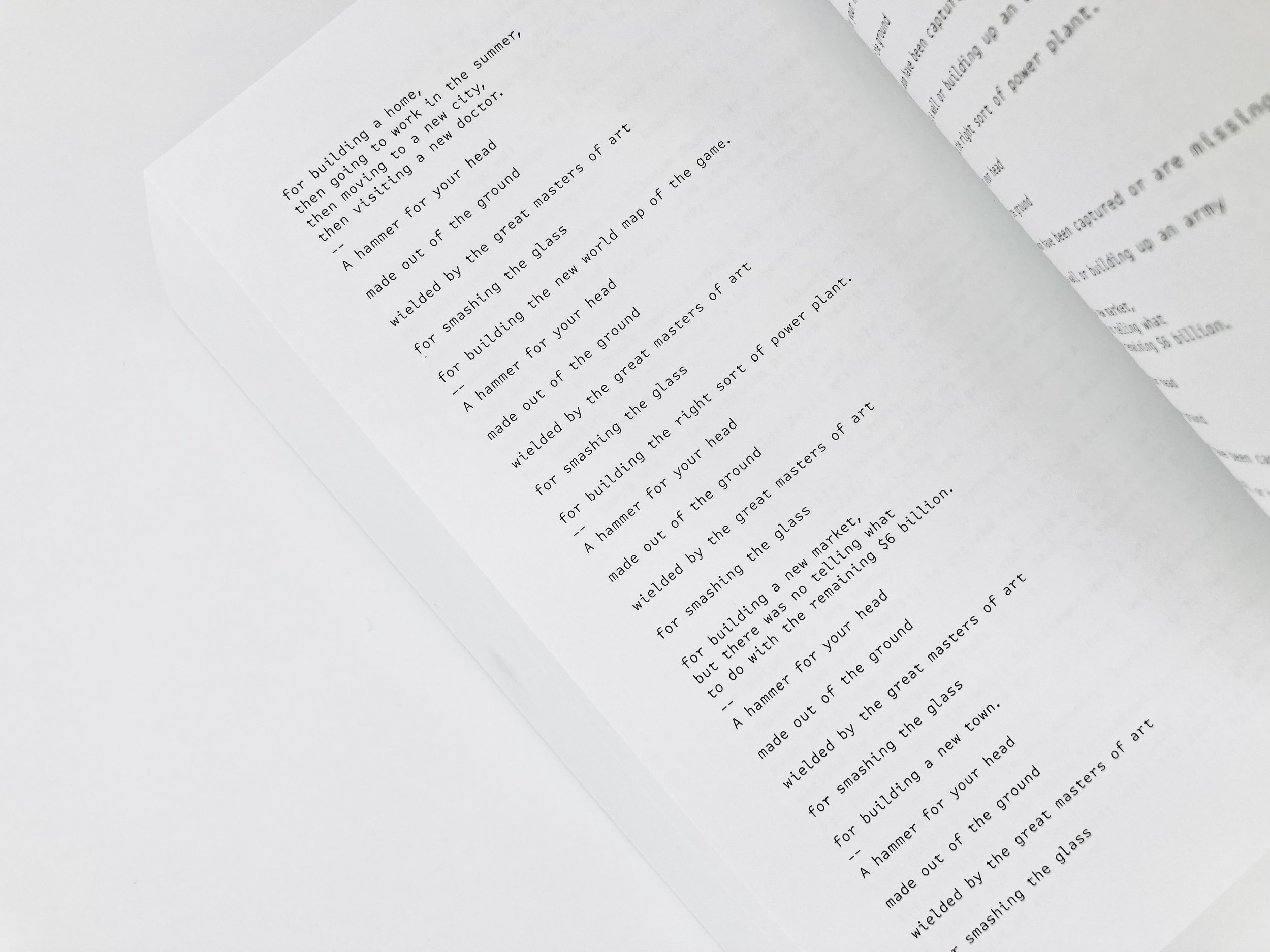Work, Life, Balance (2020) | Matt Nish-Lapidus
[Toronto]: self-published, 2020. Perfect-bound softcover book in black-and-white printed wrappers. Contents digitally printed in black and white. 21 x 14 x 6cm. [880] pages. Edition of 50. Near fine, with trace amounts of rubbing; sold on behalf of the author.
This gargantuan tome spans 880 pages, over the course of which a single computer-generated poem relentlessly unravels. Its author is Toronto-based artist Matt Nish-Lapidus, whose work explores the poetics of recombinatory computational procedures.
Work, Life, Balance results from a simple combinatorial procedure that produces variations on the template A hammer for [. . .] / made out of [. . .] / wielded by [. . .] / for smashing [. . .] / for building [. . .], whose gaps are programmatically filled with associated textual elements that were likewise authored by Nish-Lapidus. The first gap has six associated elements, while the rest have five, which yields 3750 (6 x 5 x 5 x 5 x 5) possible variations. Work, Life, Balance, then, is a poem constituted in the exhaustive enumeration of these recombinant variations, which are presented in (mathematical) lexicographic order.
Here’s the first stanza:
A hammer for the poor and the needy,
and for the rich and the poor,
and for those who want to be rich and freemade out of a bunch of things
that he's probably never seen beforewielded by the first-place team
for smashing a wall or building up an army
for building the new world map of the game.
In this project, Nish-Lapidus is clearly inspired by the work of Alison Knowles, whose computer-generated books A House of Dust (ca. 1968) and Clear Skies All Week (2011) result from similar procedures. Like the latter, Work, Life, Balance presents a single combinatorial poem that exhaustively lists all possible combinations of a set of discrete textual elements. Though similar in form, Nish-Lapidus’s book has its own striking theme: “A hammer is repurposed in over three thousand ways, exploring what it means to make and destroy through the logic of computational loops and iterations.”
In terms of persistence and heft, Work, Life, Balance evokes Heidulf Gerngross’s enormous computer-generated books Volksbuch (1978) and ABC des Raumes (2014), which each measure 1280 pages. Like these antecedents, Nish-Lapidus’s book is almost brutal in its extent—it just keeps working working working at writing out its poem. Read it aloud, from 9:00 to 5:00!
Matt Nish-Lapidus self-published Work, Life, Balance in 2020, as an edition of 50 copies. Aleator Press is thrilled to offer some of the last remaining stock from this limited print run. We are distributing these on behalf of the author, who will receive the full proceeds on all sales.
[Toronto]: self-published, 2020. Perfect-bound softcover book in black-and-white printed wrappers. Contents digitally printed in black and white. 21 x 14 x 6cm. [880] pages. Edition of 50. Near fine, with trace amounts of rubbing; sold on behalf of the author.
This gargantuan tome spans 880 pages, over the course of which a single computer-generated poem relentlessly unravels. Its author is Toronto-based artist Matt Nish-Lapidus, whose work explores the poetics of recombinatory computational procedures.
Work, Life, Balance results from a simple combinatorial procedure that produces variations on the template A hammer for [. . .] / made out of [. . .] / wielded by [. . .] / for smashing [. . .] / for building [. . .], whose gaps are programmatically filled with associated textual elements that were likewise authored by Nish-Lapidus. The first gap has six associated elements, while the rest have five, which yields 3750 (6 x 5 x 5 x 5 x 5) possible variations. Work, Life, Balance, then, is a poem constituted in the exhaustive enumeration of these recombinant variations, which are presented in (mathematical) lexicographic order.
Here’s the first stanza:
A hammer for the poor and the needy,
and for the rich and the poor,
and for those who want to be rich and freemade out of a bunch of things
that he's probably never seen beforewielded by the first-place team
for smashing a wall or building up an army
for building the new world map of the game.
In this project, Nish-Lapidus is clearly inspired by the work of Alison Knowles, whose computer-generated books A House of Dust (ca. 1968) and Clear Skies All Week (2011) result from similar procedures. Like the latter, Work, Life, Balance presents a single combinatorial poem that exhaustively lists all possible combinations of a set of discrete textual elements. Though similar in form, Nish-Lapidus’s book has its own striking theme: “A hammer is repurposed in over three thousand ways, exploring what it means to make and destroy through the logic of computational loops and iterations.”
In terms of persistence and heft, Work, Life, Balance evokes Heidulf Gerngross’s enormous computer-generated books Volksbuch (1978) and ABC des Raumes (2014), which each measure 1280 pages. Like these antecedents, Nish-Lapidus’s book is almost brutal in its extent—it just keeps working working working at writing out its poem. Read it aloud, from 9:00 to 5:00!
Matt Nish-Lapidus self-published Work, Life, Balance in 2020, as an edition of 50 copies. Aleator Press is thrilled to offer some of the last remaining stock from this limited print run. We are distributing these on behalf of the author, who will receive the full proceeds on all sales.
[Toronto]: self-published, 2020. Perfect-bound softcover book in black-and-white printed wrappers. Contents digitally printed in black and white. 21 x 14 x 6cm. [880] pages. Edition of 50. Near fine, with trace amounts of rubbing; sold on behalf of the author.
This gargantuan tome spans 880 pages, over the course of which a single computer-generated poem relentlessly unravels. Its author is Toronto-based artist Matt Nish-Lapidus, whose work explores the poetics of recombinatory computational procedures.
Work, Life, Balance results from a simple combinatorial procedure that produces variations on the template A hammer for [. . .] / made out of [. . .] / wielded by [. . .] / for smashing [. . .] / for building [. . .], whose gaps are programmatically filled with associated textual elements that were likewise authored by Nish-Lapidus. The first gap has six associated elements, while the rest have five, which yields 3750 (6 x 5 x 5 x 5 x 5) possible variations. Work, Life, Balance, then, is a poem constituted in the exhaustive enumeration of these recombinant variations, which are presented in (mathematical) lexicographic order.
Here’s the first stanza:
A hammer for the poor and the needy,
and for the rich and the poor,
and for those who want to be rich and freemade out of a bunch of things
that he's probably never seen beforewielded by the first-place team
for smashing a wall or building up an army
for building the new world map of the game.
In this project, Nish-Lapidus is clearly inspired by the work of Alison Knowles, whose computer-generated books A House of Dust (ca. 1968) and Clear Skies All Week (2011) result from similar procedures. Like the latter, Work, Life, Balance presents a single combinatorial poem that exhaustively lists all possible combinations of a set of discrete textual elements. Though similar in form, Nish-Lapidus’s book has its own striking theme: “A hammer is repurposed in over three thousand ways, exploring what it means to make and destroy through the logic of computational loops and iterations.”
In terms of persistence and heft, Work, Life, Balance evokes Heidulf Gerngross’s enormous computer-generated books Volksbuch (1978) and ABC des Raumes (2014), which each measure 1280 pages. Like these antecedents, Nish-Lapidus’s book is almost brutal in its extent—it just keeps working working working at writing out its poem. Read it aloud, from 9:00 to 5:00!
Matt Nish-Lapidus self-published Work, Life, Balance in 2020, as an edition of 50 copies. Aleator Press is thrilled to offer some of the last remaining stock from this limited print run. We are distributing these on behalf of the author, who will receive the full proceeds on all sales.
